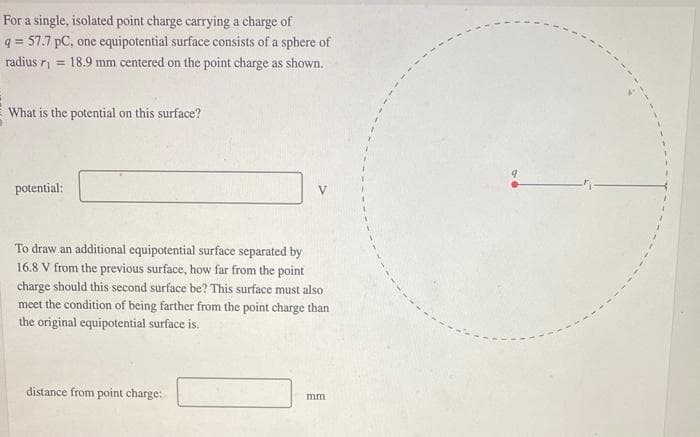For a single, isolated point charge carrying a charge of q= 57.7 pC, one equipotential surface consists of a sphere of radius r₁= 18.9 mm centered on the point charge as shown. What is the potential on this surface? potential: To draw an additional equipotential surface separated by 16.8 V from the previous surface, how far from the point charge should this second surface be? This surface must also meet the condition of being farther from the point charge than the original equipotential surface is. distance from point charge: mm 2
For a single, isolated point charge carrying a charge of q= 57.7 pC, one equipotential surface consists of a sphere of radius r₁= 18.9 mm centered on the point charge as shown. What is the potential on this surface? potential: To draw an additional equipotential surface separated by 16.8 V from the previous surface, how far from the point charge should this second surface be? This surface must also meet the condition of being farther from the point charge than the original equipotential surface is. distance from point charge: mm 2
Chapter7: Electric Potential
Section: Chapter Questions
Problem 59P: A very large sheet of insulating material has had an excess of electrons placed on it to a surface...
Related questions
Concept explainers
Dielectric Constant Of Water
Water constitutes about 70% of earth. Some important distinguishing properties of water are high molar concentration, small dissociation constant and high dielectric constant.
Electrostatic Potential and Capacitance
An electrostatic force is a force caused by stationary electric charges /fields. The electrostatic force is caused by the transfer of electrons in conducting materials. Coulomb’s law determines the amount of force between two stationary, charged particles. The electric force is the force which acts between two stationary charges. It is also called Coulomb force.
Question

Transcribed Image Text:For a single, isolated point charge carrying a charge of
q= 57.7 pC, one equipotential surface consists of a sphere of
radius r₁ = 18.9 mm centered on the point charge as shown.
What is the potential on this surface?
potential:
To draw an additional equipotential surface separated by
16.8 V from the previous surface, how far from the point
charge should this second surface be? This surface must also
meet the condition of being farther from the point charge than
the original equipotential surface is.
distance from point charge:
mm
Expert Solution
This question has been solved!
Explore an expertly crafted, step-by-step solution for a thorough understanding of key concepts.
Step by step
Solved in 2 steps with 2 images

Knowledge Booster
Learn more about
Need a deep-dive on the concept behind this application? Look no further. Learn more about this topic, physics and related others by exploring similar questions and additional content below.Recommended textbooks for you


Principles of Physics: A Calculus-Based Text
Physics
ISBN:
9781133104261
Author:
Raymond A. Serway, John W. Jewett
Publisher:
Cengage Learning

College Physics
Physics
ISBN:
9781285737027
Author:
Raymond A. Serway, Chris Vuille
Publisher:
Cengage Learning


Principles of Physics: A Calculus-Based Text
Physics
ISBN:
9781133104261
Author:
Raymond A. Serway, John W. Jewett
Publisher:
Cengage Learning

College Physics
Physics
ISBN:
9781285737027
Author:
Raymond A. Serway, Chris Vuille
Publisher:
Cengage Learning

Physics for Scientists and Engineers, Technology …
Physics
ISBN:
9781305116399
Author:
Raymond A. Serway, John W. Jewett
Publisher:
Cengage Learning

Classical Dynamics of Particles and Systems
Physics
ISBN:
9780534408961
Author:
Stephen T. Thornton, Jerry B. Marion
Publisher:
Cengage Learning

Glencoe Physics: Principles and Problems, Student…
Physics
ISBN:
9780078807213
Author:
Paul W. Zitzewitz
Publisher:
Glencoe/McGraw-Hill